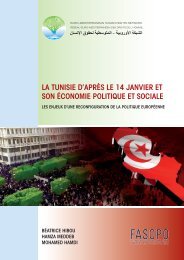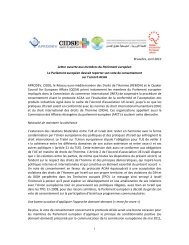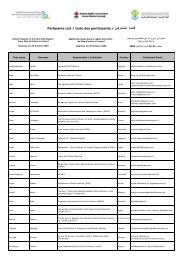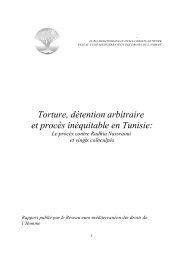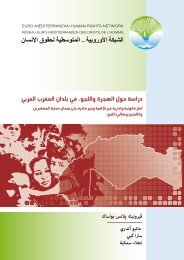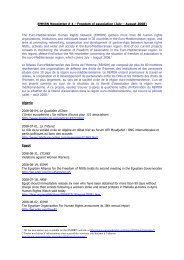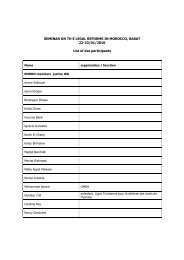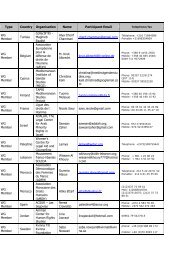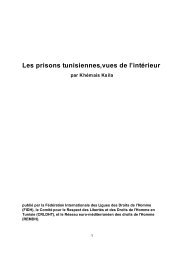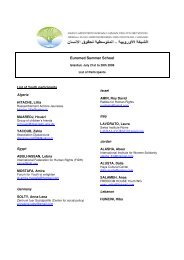tunisia after 14 january and its social and political economy - Refworld
tunisia after 14 january and its social and political economy - Refworld
tunisia after 14 january and its social and political economy - Refworld
You also want an ePaper? Increase the reach of your titles
YUMPU automatically turns print PDFs into web optimized ePapers that Google loves.
T U N I S I A A F T E R 1 4 J A N U A R Y A N D I T S S O C I A L A N D P O L I T I C A L E C O N O M YT H E I S S U E S A T S T A K E I N A R E C O N F I G U R A T I O N O F E U R O P E A N P O L I C Ycost, <strong>and</strong> ultimately of the country’s relative lack of openness to the world, contrary tothe myth of Tunisia as a ‘bridge between East <strong>and</strong> West.’II.2.A.b. The lim<strong>its</strong> of the dualistic model <strong>and</strong> specialization in downmarket outsourcingIn fact, long-term thinking on the development model should focus on possible waysto increase job creation by raising the level of specialization <strong>and</strong> by questioning adualistic model that maintains inequality, by diversifying the <strong>economy</strong>, by improvingthe educational system <strong>and</strong> more generally the infrastructure needed to increasecompetitiveness, <strong>and</strong> by a better fit between training <strong>and</strong> jobs offered, etc.Faced with intensifying global competition, improving the productivity of factors ofproduction, including labour, has become a necessity for the Tunisian government. Theintegration of Tunisia into the <strong>economy</strong> of international outsourcing has largely hinged,as we have seen, around wage pressures <strong>and</strong> more insecure working conditions leadingto de facto segmentation of the workplace between a protected population mainlyemployed in the public <strong>and</strong> certain private sectors <strong>and</strong> a population living on the marginsof legal rules <strong>and</strong> the welfare system, non-unionised <strong>and</strong> very vulnerable, whose numberhas continued to grow since the establishment of the program of structural adjustmentin the mid-1980s. It should be noted here that the informal sector in 2002 accounted for40% of jobs in the active labour force, 110 <strong>and</strong> the years of crisis have only increased thisproportion. In the context of a liberalization that has led to a destabilization of a class ofwage earners established in the 1970s, the welfare system aims less to include vulnerablecategories in ever-increasing numbers than to try to compensate for the impoverishmentof workers. 111 Specialization of the private offshore sector in low-cost outsourcing <strong>and</strong>the weakness of the onshore sector considerably hamper their abilities to create skilledjobs. In this regard, despite liberalization <strong>and</strong> accelerated privatization, the public sectorremains, with 52% of jobs created, the engine of job creation in the country. 112The offshore sector accounts for 34% of total exports from Tunisia <strong>and</strong> 70% of manufacturingexports, <strong>and</strong> contributes 17% to job creation, covering 80% of the current deficit. Althoughit appears to meet most of the conditions required to appear among the preferreddestinations for foreign investors, the Tunisian <strong>economy</strong> seems to suffer from a growinginability to attract foreign direct investment (FDI). This is what some have suggested callingthe ‘paradox of Tunisia’. 113 Heightened international competition, bringing labour costsdown, has stemmed the influx of FDI to Tunisia. Since 1998, performance in terms of FDIcan be explained largely by investment in the hydrocarbons sector <strong>and</strong> by acceleratingthe privatization process: 1<strong>14</strong> the government had accelerated the privatization process110 Report by the World Bank on the significance of the ‘informal’ <strong>economy</strong> in several countries, edited byFriedrich Schneider, ‘Size <strong>and</strong> measurement of the informal <strong>economy</strong> in 110 countries around the world’,July 2002 (available online: http://rru.worldbank.org/Documents/PapersLinks/informal_<strong>economy</strong>.pdf).111 On welfare in Tunisia, see Bl<strong>and</strong>ine Destremau <strong>and</strong> Myriam Catusse, op. cit.112 World Bank <strong>and</strong> Tunisian Ministry of Vocational Training <strong>and</strong> Employment, ‘Dynamique de l’emploi etadéquation de la formation parmi les diplômés universitaires. Rapport sur l’insertion des diplômés de2004’. http://siteresources.worldbank.org. 2008113 F. Abbate, ‘L’intégration de la Tunisie dans l’économie mondiale: opportunités et défis’, Conférencesdes Nations Unies pour le commerce et de développement, Geneva 2002, www.globalprogramme.org/tunisie.1<strong>14</strong> Béatrice Hibou, The Force of Obedience, ch. 9.67The reconfiguration of power, the socio-economicchallenges of the revolution, <strong>and</strong> European policy



